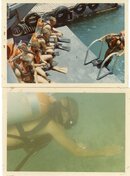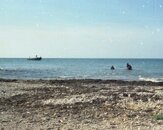In the U.S. Naval School for Underwater Swimmers, they had us start at 500 yards, and proceed to 1,500 yards. In the photo below, my buddy, Bob Means and I are on the 1,500 yard compass swim. You can see Bob has the compass on his left wrist, is holding that wrist onto his right hand, which we used to tell direction. We were allowed to surface at the 1,000 and 500 yard marks to ensure we were oriented correctly. But we still had divers trying to swim to Cuba instead of the island where Key West was located.
Now, there is a sport called Underwater Orienteering, which holds competitions in swimming a compass course. You can see their website here:
In addition to organizing international underwater sport events it is at the forefront of technical and scientific research and development.

www.cmas.org
CMAS shows several types of orienteering courses, including an "M" course, a "Star Course" and a "5 Points" course. They say that there are usually "...usually 80, 100, 120, 150 and 200 meters..." between points. You can see their description here:
In addition to organizing international underwater sport events it is at the forefront of technical and scientific research and development. It can be associate

www.cmas.org
As can be seen in this video, the Europeans have taken this underwater orienteering competitions to an entirely different level, with use of the monofin, and specialized hand-held scuba units streamlined with a compass for the orienteering work.
Enjoy,
SeaRat





